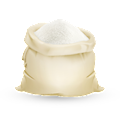MAIN INGREDIENTS
One of the most popular Swedish desserts is a rich chocolate cake known as kladdkaka. This classic Swedish creation combines eggs, cocoa (or chocolate), butter, sugar, and flour into a dense and luscious dessert. During baking, the cake should always remain moist in the center, while the outer layer is transformed into a thin, crunchy coating.
Since the cake is incredibly dense, and typically heavy on the bitter chocolate or cocoa, it is usually dusted with a delicate layer of powdered sugar, and traditionally served with a dollop of ice cream or whipped cream on the side. It is one the most beloved Swedish desserts, typically enjoyed during fika, a traditional Swedish coffee break.
MAIN INGREDIENTS
Jordgubbstårta is a traditional strawberry cake originating from Sweden. It usually consists of five parts: sponge cake (flour, sugar, eggs, cornstarch, vanilla); lemon syrup (lemon juice, water, sugar); pastry cream (eggs, sugar, vanilla, flour, butter, milk); mascarpone whipped cream (mascarpone cheese, crème fraiche, sugar, vanilla), and a garnish of fresh strawberries.
In order to assemble the cake, the sponge cake is brushed with lemon syrup, topped with pastry cream and quartered strawberries, and then with whipped cream. The process is repeated two more times, and the cake is then covered with mascarpone whipped cream and the remaining strawberries.
Våfflor are extremely popular Swedish waffles, consumed since the early 1600s, when they were shaped into squares. Today, the waffles are traditionally shaped into hearts and served with fruit jams, whipped cream, and ice cream. Because våfflor are made without yeast, they are much thinner than Belgian waffles, with a texture that is similar to pancakes.
There are two popular waffle varieties - egg waffles and crispy waffles, the egg variety being more filling than the other one. Waffles are consumed throughout the year in Sweden, but they are at the peak of their popularity on March 25th, which is known as Waffle Day.
MOST ICONIC Våfflor
View moreThis traditional Scandinavian dish is prepared with a combination of cow’s milk and beestings or colostrum – a yellow, rich milk produced by the animal right after it gave birth to a calf. The mixture is baked in the oven and the product acts as a coagulant, eventually thickening the milk to create a thick, custard-like dish.
Often compared to baked cheese, uunijuusto is traditionally enjoyed as a dessert that is often sweetened, spiced with cinnamon, and complemented by fresh berries.
Semla is the famous Swedish cream bun. This traditional Swedish dessert is made with a plain wheat bread bun which is lightly flavored with cardamom, then cut in half. The inside is filled with a layer of delicious almond paste and a generous amount of vanilla-flavored whipped cream.
The bun is finished when the top is placed on the whipped cream, and the sweet creation is lightly dusted with a layer of powdered sugar. Semla is an old-fashioned Swedish dessert that was originally invented and eaten on Fat Tuesday, the last day of indulgence before Lent.
VARIATIONS OF Semla
Smulpaj, from the Swedish words smula, meaning crumb, and paj, meaning pie, is a delicious Swedish crumb pie. It consists of a crumbly mixture poured evenly over diced fruits and berries (typically blueberries and raspberries).
It is flavored with sugar and cinnamon, then baked until crisp. This scrumptious Swedish treat is usually topped with whipped cream, vanilla custard, or ice cream. A crisp and crunchy crumb united with an irresistibly sweet and moist filling make smulpaj a popular treat served in many cafés throughout Sweden.
Hailing from Skåne region, this local version of a traditional apple cake combines apples with sugar, breadcrumbs or crumbled rye bread, butter, and cinnamon. The apples are mashed or sliced and then layered with a sweetened mixture of breadcrumbs or rye bread, and the cake is finished off with a generous amount of sliced butter that melts during baking. Äppelkaka is usually served with vanilla sauce or whipped cream on the side.
Knäck is a Swedish toffee prepared with caramelized sugar and butter or heavy cream. It is often additionally sweetened with syrups and may be enriched with various chopped nuts. The caramelized mixture is usually left to set in miniature paper molds, or it can be cut into bite-sized pieces.
The name of this Christmas staple name translates as crack or break, referring to the typically crispy texture of toffee.
This classic Swedish cake was originally named grön tårta (lit. green cake), due to its typical green-colored marzipan decoration. The recipe was first published in a 1948 edition of Prinsessornas Nya Kokbok, and it originally consisted of sponge layers coated in vanilla-flavored buttercream which were then topped with a thick layer of whipped cream and marzipan.
It became increasingly popular in the 1950s, and it soon became known as prinsesstårta. This classic is a staple at every special event in Sweden and is commonly found in most pastry shops. Modern varieties are usually dome-shaped and come with an additional layer of raspberry jelly.
MAIN INGREDIENTS
Chokladbollar, or chocolate balls, are a classic Swedish no-bake treat made primarily from oats, sugar, cocoa powder, and butter. They are often rolled in coconut flakes, sprinkles, or pearl sugar for decoration. The dough is mixed and shaped into small balls before being chilled.
Traditionally, they were known by a controversial name that has since been replaced due to its offensive connotations. In Sweden, these treats are popular year-round, while in Denmark, they are associated with Christmas. Variants include adding coffee or arrack for different flavors.
TasteAtlas food rankings are based on the ratings of the TasteAtlas audience, with a series of mechanisms that recognize real users and that ignore bot, nationalist or local patriotic ratings, and give additional value to the ratings of users that the system recognizes as knowledgeable. TasteAtlas Rankings should not be seen as the final global conclusion about food. Their purpose is to promote excellent local foods, instill pride in traditional dishes, and arouse curiosity about dishes you haven’t tried.



























